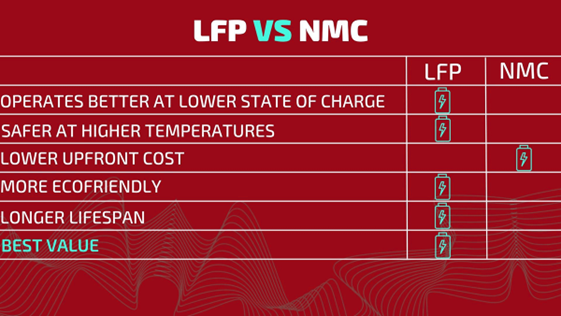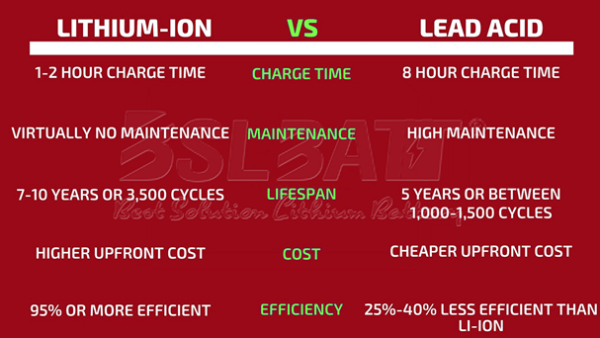The global lithium-ion battery market size is projected to expand by over 18 percent between 2021 and 2030, compared to the projected 5 percent growth in the global lead-acid battery market size during that same time period.
Lithium-ion batteries have multiple advantages that make them ideal for any operation. The battery's unique properties allow businesses to improve safety, and efficiencies, and significantly improve ROI. Lithium-ion batteries have multiple benefits over their IC and lead-acid counterparts, including faster recharge times, opportunity charging, long cycle life, and full cloud data reporting (BSL GPRS+GPS). Li-ion batteries virtually eliminate hazardous off-gassing and spills, making them safer and more eco-friendly than their competitors. We have examined and debunked the top lithium battery myths below to simplify the decision-making process.
Myth 1: Battery-powered devices cannot withstand climate fluctuations
To some, the idea that a battery can withstand a range of environmental conditions is unfathomable. For those who work in cold storage, the low-temperature freezer and refrigerator environment can put a lot of stress on lead-acid batteries, resulting in longer charging times and frequent interruptions to daily operations. They needed a lithium solution that could withstand the low-temperature factor, and lithium batteries have been proven to do this over the years, but it would be a mistake to underestimate that lithium batteries cannot be used at -25°.
Batteries are increasingly being developed to withstand harsh environmental elements, greatly increasing the durability and durability required for these conditions. While extreme heat and cold, as well as strong vibrations and exposure to moisture, can damage a battery's charge, it does & #39;t prevent the battery from delivering optimal power performance.
Enhanced testing capabilities for batteries allow manufacturers to expose batteries to harsh environments to ensure they will deliver effective and efficient performance no matter the weather. Tested at temperatures from as low as –25°C to as high as 60°C, the range in which BSLBATT batteries can deliver robust, consistent performance has increased.
Myth 2: ALL Lithium-Ion Batteries Contain Cobalt
Many people shy away from investing in Lithium-ion because of the ethical and environmental costs of mining cobalt. While many Lithium-ion batteries in everyday tech use cobalt, the truth is that not all Lithium-ion batteries are made with cobalt. In fact, the LFP (Lithium Iron Phosphate) battery chemistry is quickly surpassing NMC (Nickel Manganese Cobalt) in popularity and performance for industrial equipment.
LFP batteries are Lithium-Ion batteries that do not contain cobalt. Aside from not containing cobalt, LFP batteries are better for our environment due to the fact that they are much less toxic, with iron and phosphate readily available. LFP is one of the safest and most reliable chemistry options out of all possible alternatives for lithium-ion batteries. This is why LFP batteries continue to grow as the preferred battery choice.

Myth 3: Industrial Lithium-ion Battery Tech is “Too New”
It is commonly assumed that lithium-ion technology is too new to be the superior choice over legacy internal combustion and lead acid battery systems. In reality, Lithium-ion technology has come leaps and bounds from where it first started in 1991 and is continuously improving at a rapid pace.
The last decade has seen industrial lithium-ion begin to take over due to its reliability, low maintenance, and long cycle life. Today, lithium-ion batteries cost 97% less than they did when they first came to market and can now run for 8+ hours straight. When comparing lithium-ion batteries to their lead-acid counterpart, for example, lithium-ion is already the more economical, eco-friendly, and efficient option for users to choose from.
Lithium-ion batteries bring new technology and capabilities that have not been seen in the market previously. Each year these batteries are on the market bringing new developments such as improved lithium cell performance, BMS capabilities, and durability among others. Lithium-ion is already established as a better alternative and continued improvement will prove lithium-ion batteries are the power source of choice for the future.

MYTH 4: Battery power is unreliable
As traditional fuel-powered machines are widely considered the norm, there is a tendency to dismiss battery power as it is unknown. Concerns remain over the impact, potential downtime can have on a business as they work out how to fix the issues that have occurred.
However, modern Li-ion batteries are designed to help the user should something go wrong. Built into the battery is a battery management system (BMS) that offers a wealth of data and insights surrounding battery health and performance that keeps the battery, and in turn, the equipment, functioning at its best. Being able to monitor this data helps to prevent downtime as users can constantly measure the state of the battery. The BMS serves as an onboard computer that monitors and measures information such as the pack’s temperature, charge/discharge currents, and voltages of each cell bank.
As the BMS constantly monitors the battery’s health, it is a great tool for supporting users should something go wrong. The battery can communicate with you to identify the issue so you can get back to work as quickly as possible helping to reduce downtime. BSLBATT Li-ion batteries also feature internal contactors, which means when the equipment is off, the battery is off, helping to protect those doing maintenance to the battery.
MYTH 5: Lithium-Ion batteries aren’t recyclable
Recycling batteries is often considered impossible due to the difficulties of disposing of older nickel-cadmium (Ni-Cd) batteries. These difficulties do not apply to Li-ion batteries that are in fact incredibly recyclable. Li-ion batteries often have a second life in them (roughly 80 percent of the battery capacity remains), allowing them to be repurposed for other applications at the end of their life cycle.
Li-ion batteries do not contain the same heavy metals that used to be found in old batteries, which means that they can be safely recycled without fear of unwanted chemicals getting into your water supply.
The bottom line
Once the misconceptions around Li-ion batteries are removed, end users are left with a reliable, rugged, and sustainable power source that helps OEMs meet their electrification goals whilst delivering on their customers’ ever-evolving power application needs.
Myth 6: Industrial Lithium-ion Batteries Are Not a “Greener” Choice
It is falsely believed that Lithium-ion batteries are no better for the environment than their IC or lead acid counterparts. It’s true that we still have a long way to go in terms of making Lithium-ion technology carbon neutral and there are still environmental costs associated with extracting the lithium and disposing of the spent batteries.
However, the truth is that they’re still a better choice for the environment than lead acid or IC options. As time goes on, we’re continually developing new ways to recycle old batteries. Scientists have created new ways to recycle old materials in lithium-ion batteries to help reduce the need to mine for new materials. New research has shown that it might be easier, more cost-effective, and more environmentally friendly to extract lithium from salt water instead of mining it. Overall, the scientific community generally agrees that electric technology still has a much smaller carbon footprint than its IC counterparts.
Overall:
Although lithium-ion technology is relatively new to its market, the technology has quickly become a top pick for those in its market. It is widely agreed that lithium-ion batteries are more economical, eco-friendly, and efficient than their counterparts. While the technology does have many improvements to make, it is already considered the superior choice by those who use it and is only improving with time.











